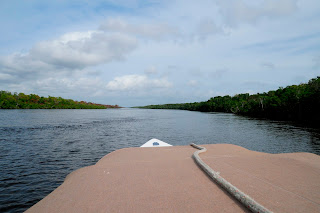

I ran through the maze of mangroves in the Shark River until I reached the Harney River. This is where I started my journey back to the Gulf of Mexico. I ran the boat along the curves of the river, enjoying the smells and beauty in front of me. The bird life was more prominent. White Ibis flew over the bow and turkey vultures were spotted sitting ominously along the river banks. The mouth of the Harney river was soon over the bow, skinny water, and oyster bars greeted me, as I made my way into the gulf.
My first plan was to go to a little beach on Hog Key, check out one of my favorite trees on the island a Royal Poinsettia. The Tide told me that's not going to happen this trip. I continued farther north to Turkey Key where the water depth was more favorable. Turkey Key was a fascinating island, with all sorts of architecture on the landscape. You could see where parts of the island appeared to be, prehistoric dug canals.
The island as a whole reminded me of other archaeologically significant Islands in Pine Island Sound. Turkey Key had some of the same features I have helped Document on other archaeological sights in Florida. The plant life was also intriguing, there were plants that you don't normally find unless you are on a prehistoric mound. I intend to go back and investigate the plant life closer in April, Hopefully in early April, before the bugs get bad. That will allow me to compare the plants from a few similar sights this summer.
Nightfall was nearing. I needed to find a good place to anchor up for the night.I thought of running up the Huston river where I spent the first night. Then I thought of the bugs. I anchored out closer to the gulf , in seven feet of water towards Duck rock. The bugs found me even far out from shore. The tent was zipped until time to get in.
The stern light was set, and I wiggled into my sleeping bag. The wind shifted and you could hear the water slapping on the hull of the boat. This rocking prompted the stern light to wobble and then fall into the water. The white light kept on shinning as it bobbed up and down farther away. I am sure by now it has made a nice night light for some Cuban family on the north coast of Cuba.
Back to my sleeping bag I went. I was about to fall asleep, when I heard the sound of an outboard motor, no big deal. It was whining and close to duck rock, or at least that is where the sound was coming from. I got out of my tent closed it quickly, and looked to see where the little boat was going. NO LIGHTS! The boat was running with no lights on. That boat was running in water one foot or less around limestone and shoals. Definitely a Local. I was glad I had a back up stern light, so he or she could see me. I then watched a 34foot crab boat and its light's disappear behind the mangrove island of duck rock in very shallow water. These island's have been a smugglers paradise for decades. I went back to my tent and laid there, and tried to sleep. A lot of things were running through my mind.
But my mind kept going back to an old picture, A picture of an crab boat tied up to a dock, not far from where I was anchored on this dark night. The name of the boat was "Miss Trial".




 I heard this Osprey chirping before I could see it. I grabbed my camera and went out searching for the sound. The Osprey was perched under the canopy of a ficus tree. The sun was at my back and the light was perfect. I took 198 photos. The fish in the photo is a sheepshead. The Osprey are excellent fishing birds. The talons of this bird are impressive, they have a 500 pound per square inch grip.
.
I heard this Osprey chirping before I could see it. I grabbed my camera and went out searching for the sound. The Osprey was perched under the canopy of a ficus tree. The sun was at my back and the light was perfect. I took 198 photos. The fish in the photo is a sheepshead. The Osprey are excellent fishing birds. The talons of this bird are impressive, they have a 500 pound per square inch grip.
.

















